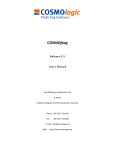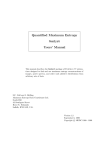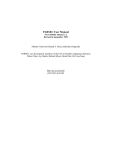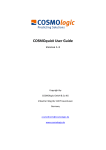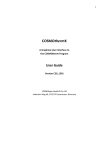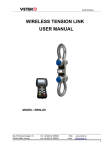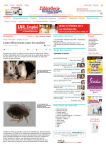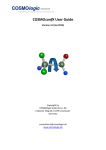Download COSMOsim3D and COSMOsar3D
Transcript
COSMOsim3D and COSMOsar3D
User's Manual
COSMOlogic GmbH & Co. KG
Imbacher Weg 46, 51379 Leverkusen, Germany
2
Introduction ................................................................................................................................ 3
Prerequisites ........................................................................................................................... 4
Technical details ..................................................................................................................... 4
Installation .................................................................................................................................. 7
Running COSMOsim3D ............................................................................................................ 7
With input file ........................................................................................................................ 7
Pair-wise similarity ................................................................................................................ 8
Keywords ................................................................................................................................... 9
General ................................................................................................................................... 9
Program Control ..................................................................................................................... 9
Random loop control .............................................................................................................. 9
Print / Write Options ............................................................................................................ 10
Self-consistent alignment mode ........................................................................................... 11
COSMOsar3D ...................................................................................................................... 11
Output ....................................................................................................................................... 11
Example.................................................................................................................................... 13
COSMOview visualization .................................................................................................. 14
3
Introduction
The Conductor-like Screening Method for Realist Solvation (COSMO-RS) has become an
efficient and versatile tool for the prediction of a broad range of fluid phase thermodynamic
properties based on quantum chemical calculations for solutes and solvents. In the framework
of COSMO-RS, the COSMO surface polarization charge density , and its molecular surface
histograms, the -profiles, have been proven to be excellent descriptors for the quantification
of the most important kinds of molecular interactions in the liquid phase, such as polar
interactions, hydrogen bonding and hydrophobicity. The superior suitability of for the
quantification of hydrogen bond interactions has been further confirmed in a recent quantum
chemical study1.
Since the same intermolecular interaction modes which govern fluid phase thermodynamics
also determine ligand-receptor-interactions, it is most plausible that a -profile based
description of ligand-ligand similarity or ligand-receptor-interactions should be very
promising. Based on these considerations the COSMOsim2 method was developed which
measures ligand-ligand similarities using the molecule-specific global -profile disregarding
the spatial distribution of the polarization charge density. This approach was shown to provide
useful discrimination of bioisosteric and random ligand pairs, especially for smaller
molecules. Besides speed, one of the major advantages of COSMOsim is that it naturally
supports scaffold hopping by using the molecular COSMO-RS sigma surface instead of the
molecular structure. Furthermore, analogy-based QSPR based on COSMOsim delivers
powerful models for properties that are mainly governed by isotropic interactions, like logS,
logP, logBB, etc.
However, the selective binding of ligands to receptors is known to be based on multiple
strong interactions, and the 3D arrangement of the interaction sites of a ligand thus plays a
crucial role. As a result, in target-dependent problems, one-dimensional COSMOsim tends to
retrieve false-positives along with true-positives. This results from the fact that the global profiles do not contain any information about the spatial distribution of the polarization
charge densities on the molecular surface. In order to overcome this deficiency, the molecular
-surface is projected onto a 3D grid in COSMOsim3D, yielding local -profiles on the grid
points. Arranging molecules with maximum overlap of the local -profiles on the grid leads
to optimal alignment and COSMOsim3D similarity. Based on the experience with onedimensional COSMOsim, COSMOsim3D can be expected to enable scaffold hopping and
structure-independent alignment in a natural way, since the alignment is based on the local
molecular -surface instead of the molecular structure.
The array of local sigma profiles (LSPs) can not only be used for alignment and as a
similarity measure as in COSMOsim3D but also as a novel set of molecular interaction field
(MIF) descriptors which is optimally suited for comparative molecular field analysis, e.g. to
generate a ligand-based model for the prediction of pKi. COSMOsar3D is an extension of the
4
COSMOsim3D method which uses the local sigma profiles of a set of aligned ligands as
descriptors for 3D-QSAR analysis.
Note that in this documentation COSMOsim3D and COSMOsar3D are documented together
since both methods are implemented in a single software. However, some options require a
license extension for COSMOsar3D and are therefore restricted.
Prerequisites
COSMOsim3D requires COSMO--surfaces of target and probe molecules. COSMO files can
be obtained from quantum chemical calculations using quantum chemical programs with
suitable COSMO implementations. Alternatively, CF-COSMO files (with the extension
.fcos) generated by COSMOquick or COSMOfrag can be used. CF-COSMO files provide
approximate COSMO σ-surfaces based on the 3D-geometry of the molecule and the
COSMOfrag database of precalculated σ-profiles. For ionic compounds, CF-COSMO files for
different conformers can be generated from a COSMO file of one conformer of the molecule.
COSMO and CF-COSMO files contain information about the positions (xi, yi, zi,), the areas
(ai), and the COSMO polarization charges (qi) for all COSMO surface segments.
Technical details
In one-dimensional COSMO-RS methods like COSMOtherm or COSMOsim, a locally
averaged polarization charge density i is calculated for each segment i according to the
standard procedure3, using an averaging radius of 0.5 Å. Standard -profiles are generated as
histograms with -bin width of = 0.1 e/nm² from all segments of a molecule. For the
generation of a -profile the area of each segment i is associated to the two neighboring grid centers of the actual value i, denoted as i+ and i-, according to -distance weights
wi ( i i )
wi ( i i )
(1)
This weighting generates a smooth and charge conserving assignment of the COSMO surface
segments to histograms, ensuring that the integral of the -profile is the total surface of the
molecule, and that the -weighted integral, i.e. the first moment of the histogram, is the sum
of the original COSMO charges, i.e. the negative of the total charge of the molecule.
Instead of generating just one such one-dimensional -profile for the entire molecule, in
COSMOsim3D a local one dimensional -profile is generated at each grid point of a regular
3D grid, i.e. a 4-dimensional histogram, with three Cartesian dimensions (x,y,z) and as
fourth dimension. For the 16 neighboring grid points of a segment i with coordinates (xi, yi,
zi,i) in the 4D space, the weights w x , w y , w z , w are computed in complete analogy to
eq. 1, and the segment area is assigned to the 16 neighboring grid points according to the
product of the four weights. This weighting ensures a smooth linear cross-over of the segment
assignment if a surface segment is moved between the grid points.
5
In the first step of the COSMOsim3D procedure, the target molecule is moved to the center of
the cubic grid, followed by the calculation of the local sigma profiles (sp3d1) on the grid
points. Next, the probe molecule in question is centered and the local sigma profiles (sp3d2)
on the grid points are calculated. Then the 3 dimensional -similarity SMS3D is calculated as
a weighted sum over the -similarities of the local -profiles according to
SMS 3D( sp3d1, sp3d 2)
(a1(ix, iy , iz ) a2(ix, iy , iz ))sms(sp3d1(ix, iy , iz ), sp3d 2(ix, iy , iz ))
ix ,iy ,iz
(a1(ix, iy , iz ) a2(ix, iy , iz ))
ix ,iy ,iz
(2)
where a1(ix, iy , iz ) and a2(ix, iy , iz ) are the total intensities of the local target and probe profiles at the grid point, respectively. The denominator is identical to the sum of the total
surface areas of target and probe. The SMS (sigma-match similarity) calculations are
performed according to reference 2, with the default parameters derived in that paper.4 A
target focussed or probe focussed similarity can be calculated by using the area of the target
-profile or probe -profile, respectively, for normalization.
Starting from a number of determined and random orientations, the position of the probe
molecule is optimized until maximum similarity is reached. This is done by a trial-and-error
line search in the direction of each of the 3 unit-translation and unit-rotations, with minimum
steps of 0.01Å and 0.1°, respectively. After each translational or rotational step the SMS3D is
re-evaluated and the step is accepted if it leads to an increase of similarity. The first 21
starting points in this procedure are determined, the following are random orientations. In
order to achieve maximum performance of COSMOsim3D routine, for each start position of
the probe the optimization of the probe vs. the target is first performed on a grid with 3-fold
grid distance, which reduces the number of grid points for the SMS evaluation by a factor 27.
After rough convergence on this crude grid, the optimization is continued on the fine grid if
the achieved similarity is higher than a certain percentage (70%) of the maximum similarity
achieved on the crude grid before, and if the optimized position is sufficiently distant from
previous final points of crude grid optimizations.
Beyond the basic pair-wise alignment and similarity calculations, COSMOsim3D can also be
used to build a self-consistent model from several diverse molecules which can then be used
as a model target for the alignment of the probe molecules. For such a self-consistent model
the first n molecules of a list of m molecules are selected as target compounds. First, a
standard COSMOsim3D alignment for the first two molecules is carried out. Then the third
molecule is aligned in a way to achieve maximum similarity with the averaged local sigma
profiles of the previous compounds. This procedure is continued to the n-th molecule. After
this first cycle is finished, the program starts again with the first compound and re-aligns it in
order to achieve maximum similarity with the following n-1 molecules. The same is done for
the other n-1 molecules. The self-consistency procedure is stopped when the total average
6
similarity in a loop has converged up to a predefined convergence criterion. Finally the
remaining m-n compounds (probes) are aligned in order to achieve maximum average
similarity with respect to the averaged local sigma profiles of the first n molecules (the
"model target"). This procedure results in a consistent alignment of the entire set of
compounds.
Since the self-consistent alignment can be biased by the alignment of the first two molecules,
a super-self-consistent mode can be selected, in which the algorithm uses each of the first n
molecules once as a start compound for the self-consistent procedure. The optimal alignment,
i.e. the one with the maximum average alignment on the n molecules, is then chosen as a
model to which the remainder of the list, i.e. the probe molecules, are aligned.
7
Installation
The COSMOsim3D and COSMOsar3D distribution contains the executable program and
some examples in a zip archive. Extracting the zip archive cosmosim3d.zip will
automatically create the following file directory tree:
binLinux32/cs3d
binLinux64/cs3d
binWindows32/cs3d.exe
binWindows64/cs3d.exe
/installation directory/COSMOsim3D
docs/
examples/
Linux executables
Window
executables
Documentation
Example input
and output files
for various
options
To install COSMOsim3D and COSMOsar3D on a Linux or Windows system, copy the
appropriate executable to a local directory and set the path.
If using Bourne Again Shell (bash) on a Linux 64-bit system, add to your .bashrc-file:
export PATH=$PATH:/software/COSMOsim3D/binLinux64.
In a Windows environment, set the path from the system control. From the Windows "Start"
menue, select "Control Panel", then "System". Select the "Advanced" tab. With the
"Environment Variables" button at the bottom of the window you get a dialogue where you
can edit several variables. Edit the "Path" variable from the lower part and add the path to the
directory where the COSMOsim3D executable cs3d.exe is located. If the path is set
correctly, you should be able to call COSMOsim3D on the DOS shell from any directory by
typing cs3d.exe.
If the path for the COSMOsim3D executable is not set, you can still run a COSMOsim3D
calculation by typing in the absolute path for the executable, e.g.
C:\Program Files\COSMOlogic\COSMOsim3D\binWin32\cs3d.exe.
Running COSMOsim3D
Running cs3d without options will print a help message with a list of keywords.
With input file
Execution of COSMOsim3D with a text input file allows for alignment of a list of molecules
with the first molecule in the list and also for a self-consistent alignment using up to 9 target
molecules. A formatted input file consisting of two parts is required:
Three global command lines.
List of .cosmo / .fcos files.
8
The number of target molecules is expected as the first entry in the first line with keyword
NSC= and is mandatory. With NSC=1 a single molecule is used as template for the alignment.
For a self-consistent alignment, COSMOsim3D can use up to 9 target cosmo files (NSC=9) to
generate an averaged target sigma profile. A super-self-consistent alignment is done when the
number of molecules used to start a self-consistent alignment is indicated with keyword
NSCSTART=. The path for the cosmo files is indicated with keyword fdir=. Additionally, the
command lines may contain any of the keywords listed below. Lines starting with # are
ignored.
Example input file for a super-self consistent alignment using 3 target molecules, where each
of the target molecules is used as start molecule for a self-consistent alignment cycle. A local
sigma profile file without compound names is written (only with COSMOsar3D license):
NSC=3 NSCSTART=3
NRAND=100 WRTLSP NOLSANAM
fdir=compounds
mol_18.cosmo
THIOL_14.cosmo
mol_09.cosmo
COO_23A.cosmo
SQ29852_2A.cosmo
SQ29852_2T.cosmo
THIOL_20A.cosmo
...
...
With input file file.inp, COSMOsim3D is started by
Linux systems:
cs3d file.inp
Windows systems: cs3d.exe file.inp
Pair-wise similarity
The similarity of pairs of cosmo files can be determined on the command line. The general
syntax is:
Linux systems:
cs3d file1 file2 [KEYWORD]
Windows systems: cs3d.exe file1 file2 [KEYWORD]
file1
= target compound (.cosmo or .fcos file)
file2 = probe compound (.cosmo or .fcos file)
KEYWORD is optional. If no keywords are given, the default values will be used. For a list of
keywords, refer to section “Keywords”.
Example for the execution of COSMOsim3D with cosmo files for two compounds on the
command line.
9
> cs3d benzene.cosmo toluene.cosmo
STATUS (cmpd,sc-cycle,ssc-cycle): 1 1 1
STATUS (cmpd,sc-cycle,ssc-cycle): 2 1 1
final similarities in_grid
0.737 0.817 0.707 0.833 0.942 0.833 9 9
benzene_toluene.inp toluene.cosmo
COSMOsim3D stops after
2 compounds
Keywords
List of keywords with default values in [ ], some applicable with COSMOsar3D license only:
General
LICENSEDIR=xxx
FDIR=xxx
sets path for the directory containing the license file license.ctd.
Note that the path has to be set in ' or ". If omitted, the license file is
searched for in the $PWD and $HOME directories.
sets path for the directory containing the .cosmo / .fcos files of the
compound list.
Program Control
TARGETFOCUS
PROBEFOCUS
SMSEXP=xxx
MIN1D=xxx
GRIDS=xxx
GRIDLSP=xxx
IDELSIG=i
DROT=xxx
DTRANS=xxx
ALLOW_INV
SETORI2FIRST
TDIR
TDIR=xxx
sets target focussed SMS3D for optimization.
sets probe focussed SMS3D for optimization.
raises the SMS values calculated on the grid points to the power of xxx.
sets minimum 1D-similarity to continue. [0.10]
sets grid spacing in Angstrom. [1.00]
sets LSP / LSM grid spacing in Angstrom. [1.00]
scaling factor for sigma intervals in LSP files. [6]
sets angle resolution in degree. [0.10]
sets translational resolution. [0.01]
enables inversion steps (may destroy stereo chemistry).
moves the origin to the center of the first compound. Applies only when
fields are written with WRTLSM/WRTLSMA/WRTLSP/WRTLSPA keywords.
triggers the creation of a cs3d_YYYYMMDD_HHMMSS_XXXXXX folder in the
current working directory; all output files will be stored there.
allows for selecting a specific xxx folder for output files, which will be
created if it does not exist.
Random loop control
NSC
number of target compounds used in the self-consistency cycle [1].
NSC>1 triggers the self-consistent alignment mode.
MINPS=xxx
sets minimum relative similarity of current optimum to continue with
fine grid search for random loop. [0.50]
10
MINGD=xxx
sets minimum geometric distance relative to previously considered
optima to continue random loop. [0.30]
NRAND=nnn
integer specifying number of random trials. [9]
NRAND=0
starts from initial geometry only, no random loop.
NRAND=-1
leaves the probe molecules unchanged.
SETTR=dx,dy,dz,dphix,dphiy,dphiz with NRAND=-1
moves probe by dx, dy, dz vectors and rotates probe along the axis
given by dphix, dphiy, dphiz. The norm of the vector dphix, dphiy,
dphiz determines the rotation angle (in degree).
SETBOX=sx,sy,sz,nx,ny,nz with NRAND=-1
sets the box start coordinates and the number of grid points for each
direction.
SETORI=orix,oriy,oriz with NRAND=-1
keeps the molecules and sets the origin.
NRAND=-2
centers first (target) compound and moves all others by the same shift.
NRAND=-3
moves the origin to the center of the first compound and leaves the
compounds unchanged.
NRAND0=nnn
integer specifying start of randomized trials, neglects the initial
geometry. [0]
Print / Write Options
PRINTRAN
triggers printing of random loop results.
STORERAN
triggers writing of random loop probe geometry.
WRTCOS
triggers writing of a translated/rotated probe COSMO file.
CENTER
applies only for WRTCOS keyword
WRTSDF=xxx
triggers writing of one SDF file for all compounds; new coordinates are
replaced in the template xxx. By default, COSMO files and molecules
in the SDF or MOL2 template are matched by coordinates. Structures in
the template sd file should be the same as those you want to write to the
new sdf. Also, the order of the atoms in the sd / mol2 file should be
identical to the order of atoms in the .cosmo file. Hydrogen atoms are
required to be present in the template sd file. If no match is found for
the atoms then COSMOsim3D tries to match by molecule names.
WRTMOL2=xxx
triggers writing of one MOL2 file for all compounds; otherwise
identical to WRTSDF.
REORDERCF
triggers writing of molecules in the SDF or MOL2 file in the same
order as in the xxx template, rather than in the order of input COSMO
files. Requires WRTSDF or WRTMOL2.
WRTLSP
writes a local sigma profile file named <compoundname>.lsp where
compoundname is the name of the .cosmo / .ccf / .fcos file as used in
the input file or on the command line.
11
WRTLSPA
writes all local sigma profiles to one file named <inputfilename>.lsp
where inputfilename is the name of the input file.
WRTLSM
writes a local sigma moment file named <compoundname>.lsm where
compoundname is the name of the .cosmo / .ccf / .fcos file as used in
the input file or on the command line.
WRTLSMA
writes all local sigma moments to one file named.
<inputfilename>.lsp where inputfilename is the name of the input
file.
NOLSANAM
switches off writing of compound names in .lsp and .lsm files.
Applies only with one of WRTLSP, WRTLSPA, WRTLSM, or WRTLSMA.
WRTSMS
triggers writing of a local sms file. The .sms file is required for
visualization of molecular similarity with COSMOview.
COMPRESS={ZIP|GZ} triggers writing of .lsp, .lsm and .sms files in ZIP or GZ format.
OUTFIL
triggers writing of the translated/rotated geometry as CS3D.xyz.
OUTFIL=xxx
sets the filename for the results. By default the format is xyz. The
extension pdb is optional.
Self-consistent alignment mode
NSC
number of target compounds used in the self-consistency cycle [1].
NSC>1 triggers the self-consistent alignment mode.
NSCSTART
number of compounds used to start self-consistency cycle [1].
NSCSTART>1 triggers the super-self-consistent alignment mode.
DELSCCONV
convergence criterion for average similarity in self-consistency mode
[0.01].
KSCMAX
Maximum number of self-consistency loops [5].
COSMOsar3D
Molecular fields for COSMOsar3D are written with keywords WRTLSP (WRTLSPA) and WRTLSM
(WRTLSMA) and can be used for subsequent PLS analysis. The NOLSANAM keyword switches of
writing of compound names in .lsp and .lsm files, so that the files can be used directly for
PLS in the open3dqsar program5.
Output
In general, all output is written to the working directory except when writing to a subdirectory
is triggered with the TDIR keyword.
If COSMOsim3D is run with input file file.inp, an output file file.out will be written in
addition to the standard output which is printed to the screen. The output file starts with
information about the program version and license. The keywords from the input file are
printed to a separate line. In the case of a super self-consistent alignment, the name of the start
12
compound yielding the best averaged similarity of the target compounds is also printed to a
separate line. In the following, one line per molecule is printed to the output file.
number of the current compound in the compound list of the input file.
six different similarity values per compound:
o SMS3D 3D sigma similarity as calculated by COSMOsim3D, eq. (1)
o TARGETSMS3D target focussed 3D similarity
o PROBESMS3D probe focussed 3D similarity
o SMS1D global molecular similarity
o TARGETSMS1D global target focussed molecular similarity
o PROBESMS1D global probe focussed molecular similarity
integer value indicating the number of the random start orientation leading to the
optimal alignment.
integer value indicating the lowest number of a random start orientation leading to an
alignment with an SMS value within a certain threshold of the best SMS3D value found.
sc-comp for target molecules, in_grid / mol_out for probe molecules (indicates if the
molecule is inside or outside the 3D grid).
file name of the current molecule.
The standard output, usually printed to the screen, contains a status line and a similarity line
per compound.
Entries in the status lines are the number of the current compound and the numbers of the
self-consistency cycle and super-selfconsistency cycle.
Entries in the similarity lines are:
in_grid / mol_out indicates if the molecule is inside or outside the box.
six different similarity values per compound, as in the output file.
integer value indicating the number of the random start orientation leading to the
optimal alignment.
integer value indicating the lowest number of a random start orientation leading to an
alignment with an SMS value within a certain threshold of the best SMS3D value found.
Input file name.
File name of the current probe molecule.
Keywords from the input file.
In the case of a self-consistent or super self-consistent alignment the standard output written
to the screen contains a protocol of the complete alignment procedure. There are several
blocks corresponding to the cycles in the self-consistent run. The self-consistency procedure
is finished when a line stating "self-consistency achieved !" is printed.
After the self-consistency is achieved, the compounds which are not part of the selfconsistency cycle, i.e. the probe molecules, are aligned and the similarities to the averaged
sigma-profiles from the self-consistent procedure are printed.
13
Additional output files are:
_tr.cosmo
files
The _tr.cosmo files contain the aligned (translated and rotated) molecules, i.e. structures and
sigma surfaces. Writing of the _tr.cosmo files can be triggered explicitly with the WRTCOS
keyword. Since some other options require the _tr.cosmo files for further processing, the
_tr.cosmo are also written without the WRTCOS keyword if another option (e.g. WRTLSPA)
requires this.
.sms
files and _tr.sms files
Writing of the .sms files is triggered by the WRTSMS keyword. The .sms files contain the local
similarity information in a way which can be visualized with COSMOview: The local values
of the COSMOsim3D similarity are used to control the COSMO surface transparency. By
default, regions with high similarity are shown with low transparency and thus have intensive
colors, while areas with low similarity get high transparency, so that mainly the ball & stick
structure of the molecule appears. Note that visualization of molecular similarity with
COSMOview requires _tr.cosmo and either .sms or _tr.sms files.
_all.sms
files
In the case of a self-consistent alignment using more than one target compound, WRTSMS will
also write a file named file_all.sms, where file.inp is the name of the input file. In this
file, the averaged similarity of the target molecules is used to control transparency of all
molecules. This may be useful to identify relevant regions in molecules for binding.
.lsp
files and _tr.lsp files
.lsp files contain the local sigma-profiles computed by COSMOsim3D. Writing of .lsp /
_tr.lsp files per compound (compoundname.lsp) is triggered by the WRTLSP keyword, while
.lsp files for the complete compound list (named file.lsp using the name of the input file
file.inp) are written with the WRTLSPA keyword. Note that when WRTLSP or WRTLSPA
keywords are used, _tr.cosmo files will be written additionally.
.lsm
files
Similar to the .lsp files, COSMOsim3D can write files containing the local sigma-moments.
.lsm files can be written per compound (compoundname.lsm) with the WRTLSM keyword, or,
alternatively, for the complete compound list (file.lsm) with the WRTLSMA keyword. Both
keywords also trigger writing of _tr.cosmo files.
Example
In the following, an example procedure for the alignment of a data set of THR ligands is
described in detail. In the subdirectory examples of the COSMOsim3D installation directory,
a prepared input file named thr-align.inp can be found.
14
NSC=1
NRAND=50 WRTSMS
fdir=thr-ligands
45.cosmo
1.cosmo
2.cosmo
3.cosmo
4.cosmo
5.cosmo
6.cosmo
...
With this input file, an alignment using one target compound and 50 start orientations of the
probe compounds is started by COSMOsim3D. The compound list consists of 88 compounds
which are located in the subdirectory examples/thr-ligands of the installation directory.
To run this alignment job call cs3d on a shell (with ">" the screen output is redirected to a
file):
linux systems:
cs3d thr-align.inp > thr-align.log
windows systems:
cs3d.exe thr-align.inp > thr-align.log
After cs3d has finished, the following files (in addition to the other example files) should be
present alongside thr-align.inp:
thr-align.out: the output file
thr-align.log: the redirected screen output
_tr.sms files for all 88 compounds, i.e. 1_tr.sms, 2_tr.sms, 3_tr.sms, ...
_tr.cosmo files for all 88 compounds, i.e. 1_tr.cosmo, 2_tr.cosmo, 3_tr.cosmo, ...
The .sms files can be visualized with COSMOview as described below.
COSMOview visualization
The .sms files written by COSMOsim3D can be visualized with COSMOview, a free
molecular structure viewer.
COSMOview can display one molecule per window or multiple frames with molecules in a
multiframe mode. The multiframe mode is useful for visualizing aligned molecules in
parallel. Rotation and zoom can also be done for all frames in parallel. The number of frames
can be set with a right mouse button click on the box in the bottom right corner of the
COSMOview window.
If .sms files are loaded, the window also features sliders to adjust the surface transparency
based on the local sms values. The local sms values are used to control the COSMO surface
transparency. With default settings, surface parts with high similarity are displayed with low
transparency and intensive colors, while areas with lower similarity appear more transparent,
so that the underlying molecular structure is visible.
15
The following options can be selected from the menu bar:
OPEN : Open one or more files from the file system. File types can be selected from the
pull-down menu. To visualize a .sms file, select FILES OF TYPE: cosmo file (*.wrl, *.cosmo,
*.fcos, *.ccf, *.sms). If several files are selected and opened, COSMOview will
automatically generate an appropriate multiframe window.
SAVE
: Graphics can be saved, optionally with transparent background.
RESET CAMERA
: Reset the camera to its initial position.
LINK CAMERA : In a multiframe window, apply camera movements (rotation and zoom) to
all frames. By default, cameras in a multiframe window are linked.
ARRANGE ALL WINDOWS
changed.
SETTINGS
: The arrangement of multiple COSMOview windows can be
: Change color, labels, atom settings, bond settings and so on.
DISPLAY SIGMA SURFACE
: If a surface is loaded, it can be hidden and shown again.
16
DISPLAY MOLECULE
: The molecule structure can be hidden and shown again.
DISPLAY WIREFRAME : Instead of closed object surfaces it is possible to show only the wire
frame. This option works for surfaces, atoms and bonds.
USE CHARGE DENSITY PICKER : To get an idea of the quantitative surface charge density at a
given point, you can activate the charge picking mode and move the cursor over the surface. A slider at the right-hand side will display the charge density at the spot you are
pointing on. However these values can only be approximated and are not guaranteed to be
entirely precise. This is mainly an effect of interpolation between the reduced grid size
compared to .cosmo files. Please also note that since COSMOview uses an internal color
correction, the legend produced will not be applicable to images obtained by other means than
COSMOview, e.g. third-party browser plug-ins.
DISPLAY INFO : Shows a few data on grid size and charge for
Movement: Molecules can be moved using the mouse buttons
Rotate the molecule by dragging the mouse with the left button pressed. If you move the
mouse quickly, you can give the molecule a spin to have it turn by itself.
Zoom in and out with the right mouse button pressed or simply by turning the mouse wheel.
1
A. Klamt, J. Reinisch, F. Eckert, A. Hellweg, M. Diedenhofen, Polarization charge densities
provide a predictive quantification of hydrogen bond energies, PCCP 2011,14, 955-963.
2
M. Thormann, A. Klamt, M. Hornig, M. Almstetter, COSMOsim: Bioisosteric similarity
based on COSMO-RS -profiles, J. Chem. Inf. Model. 2006, 64, 1040-1053.
3
A. Klamt, COSMO-RS: From Quantum Chemistry to Fluid Phase Thermodynamics and
Drug Design, Elsevier: Amsterdam, 2005.
4
M. Hornig, A. Klamt, COSMOfrag: A novel tool for high-throughput ADME property
prediction and similarity screening based on quantum chemistry. J. Chem. Inf. Model. 2005,
45, 1169-1177.
5
P. Tosco, T. Balle, An open-source software aimed at high-throughput chemometric analysis
of molecular interaction fields, J. Mol. Model. 2011, 17, 201-208.

















